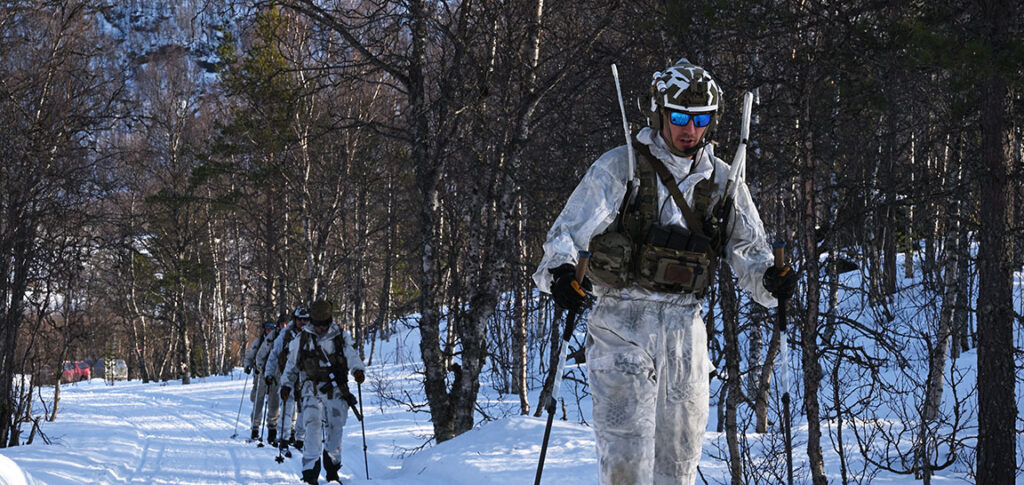U.S. Air Force Tech. Sgt. Daniel Musso, a 57th Rescue Squadron Joint Terminal attack controller, participates in Nordic Response 24 in Moen, Norway. TECH SGT. JUSTIN CARNAHAN/U.S. AIR FORCE
THE WATCH STAFF
Russia has moved its military training exercises away from the Norwegian Sea into the Barents Sea around the Kola Peninsula, according to a study by Norwegian researchers and published by High North News, a Norwegian newspaper. The shift in Russian tactics remains shrouded in secrecy, but the study concluded that the most likely reason for conducting the exercises closer to home is to conserve fuel and ammunition for use in Russia’s ongoing war in Ukraine and to fortify defenses around Russia’s military installations in the Kola Peninsula. The increased activity of NATO forces in the area, including the recent Nordic Response exercise held in March 2024, may have also played a role, they said.
The Russians haven’t issued a Notice to Air Missions — or NOTAM — to warn aviators of an exercise in the Norwegian Sea since the start of the war with Ukraine in February 2022, according to research conducted by Kristian Åtland, a senior research fellow at the Norwegian Defence Research Establishment (FFI), Barents Observer Editor Thomas Nilson, and Nord University professor Torbjørn Pedersen. To determine the scope of Russian military activity in the region, the team looked at NOTAMs from 2015 to 2023 off the Norwegian coast.
The study found that Russia has shifted most of its activity north into the Arctic. This development has been good for Norway, Åtland said. “It will affect civilian activity off the Norwegian coast to a lesser degree, whether that is fisheries or civil ship and air traffic. There are fewer disturbances for the fisheries and civilian ship and air traffic now…The problem for the civilian activity has been having to sail around closed-off areas, which could entail extra costs in terms of fuel.” In fact, since the beginning of the Ukraine invasion, Russia hasn’t issued a NOTAM south of the Arctic Circle, the study found.
Why that is the case isn’t certain, but the researchers found two scenarios that are likely behind Russia’s change in tactics. One is that a costly war in Ukraine has drained resources and constrained Russian activities. “The number of available aircraft and vessels are lower than before or by extension: They want to save ammunition and rockets to use them in the Ukraine war, rather than exercises in the Norwegian Sea and the Barents Sea,” Åtland said. The other scenario is that Russia is prioritizing protecting nuclear assets and its Arctic position, researchers said. “There is a lot of focus on the bastion defence in the Barents Sea and the need to protect the patrol areas of the strategic submarines there. That could be part of the explanation.”
Åtland continued, “I believe this with nuclear weapons to be both relevant and important. On the Russian side, there is currently a lot of nuclear deterrence. They are very concerned with it. I believe that this is an important part of explaining the behavior change in the past two years and the increased focus on the Barents Sea.” Other possible scenarios are that recent NATO activity and “pushback” from Nordic countries have deterred Russia, or that Russia realized its demonstrations of military force off the Norwegian coast weren’t having the desired effect.
Russia’s Arctic strategy rests on three pillars, according to a 2020 article in the Center for Strategic and International Studies. Enhancing homeland defense, specifically a forward line of defense against foreign incursion as the Arctic attracts increased international investment; securing Russia’s economic future; and creating a base from which to project power into the North Atlantic.
Considering those strategic goals, the recent lack of symbolic response from Russia during NATO exercises in the area is striking. In 2018, during NATO’s Trident Juncture exercise, Russia displayed demonstrations of its military strength far south into the Norwegian Sea. “The Russians established a firing range on top of a Trident Juncture exercise area. It was clearly politically motivated,” Åtland said. In contrast, during the recently completed NATO Nordic Response exercise in March 2024, which included over 20,000 troops from 13 countries in exercises across northern Norway, Finland and Sweden, Russia didn’t respond as it had in 2018 or in a later NATO drill in 2022. “Our impression is that Russia has not acted particularly provocatively in connection with this exercise. They had many vessels and aircraft out to surveil the exercise. That is normal and expected behavior from the Russian side,” said Åtland, noting, however, that Russia did not issue a NOTAM.
Russia’s recent reticence to deploy military forces in international waters near Norway, an action legal under international law, may just be a readjustment to focusing on areas farther to the east in NATO. Finland joined the alliance in 2023. “Russia will likely attempt to strengthen its military presence in other regions, such as by the border to Finland. This is a new situation in the sense that NATO’s border against Russia has doubled in length. It is a worry for Russia, which will likely attempt to strengthen its military presence on the eastern side of this border in the republic of Karelia and Kalingrad by the Baltic Sea,” Åtland stated.

